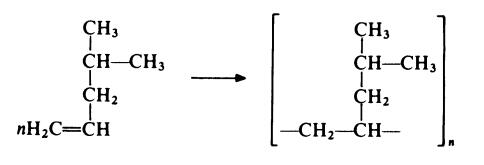POLY(4-METHYL-1-PENTENE) Chemische Eigenschaften,Einsatz,Produktion Methoden
S-S?tze Betriebsanweisung:
S24/25:Berührung mit den Augen und der Haut vermeiden.
Chemische Eigenschaften
Poly(4-methyl-1-pentene) was first introduced in 1965 by Imperial Chemical
Industries Ltd (UK) but since 1975 the polymer has been manufactured solely
by Mitsui Petrochemical Industries Ltd. Polymerization is carried out using
a Ziegler-Natta catalyst such as titanium trichloride/diethylaluminium chloride in a hydrocarbon diluent at atmospheric pressure and 30-60°C:

The commercial material contains a comonomer, possibly 1-hexene, which
enhances clarity. The polymer configuration is predominantly isotactic.
Generally, this material has the basic physical properties to be expected
from a crystalline polyolefin but in some respects it offers significant improvements over other polyolefins. One outstanding property of poly(4-methyl-l-pentene) is the very low specific gravity, which at 0.83 is the lowest of current
polymers. The crystalline melting point is 240°C and the Vicat softening
temperature is 179°C; these high values mean that a useful form stability is
maintained up to about 200°C. The transparency of the polymer is of a high
order, being comparable to poly(methyl methacrylate) and polystyrene.
Poly(4-methyl-l-pentene) exhibits resistance to oxidizing and other chemical
environments broadly similar to that shown by polypropylene; however,
poly(4-methyl-l-pentene) does undergo environmental stress cracking
comparable to low density polyethylene. The permeability of poly(4-methyl-I-pentene) to gases and water vapour is considerably higher than that for
other polyolefins. Poly(4-methyl-l-pentene) may be extruded and injection
moulded using standard equipment. The material has been used in several
applications where transparency and heat resistance are required, e.g. medical and laboratory ware.
Verwenden
Coating for paper food containers for microwave and conventional ovens. Release coatings for food and synthetic leather. Molded into medical labware. Film for decorative laminates and printed circuit boards.
POLY(4-METHYL-1-PENTENE) Upstream-Materialien And Downstream Produkte
Upstream-Materialien
Downstream Produkte

